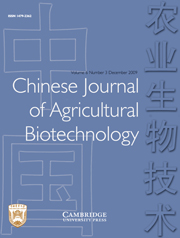Article contents
Cloning, expression and immunogenic characterization of the apxIIA gene of Actinobacillus pleuropneumoniae
Published online by Cambridge University Press: 15 June 2007
Abstract
The structural gene encoding ApxII toxin (apxIIA) was amplified from the genomic DNA of Actinobacillus pleuropneumoniae (APP) strain HB08 (serotype 2) and cloned into the prokaryotic expression vector pET-28a. SDS-PAGE and Western blot analysis showed that the apxIIA gene was expressed in Escherichia coli BL21 (DE3) and the expressed products could react with ApxII antibodies. The recombinant ApxIIA was purified from the inclusion bodies. Kunming mice were intraperitoneally vaccinated twice, with an interval of 2 weeks, using unfolded/refolded recombinant proteins, the native ApxII toxin extracted from the cultural supernatant of a strain of APP serotype 7 (APP-7) or phosphate-buffered saline (PBS). Serum antibody was examined by ApxIIA-specific enzyme-linked immunosorbent assay (ELISA) 2 weeks after every vaccination. Two weeks after the second vaccination, mice were challenged intraperitoneally with a lethal dose of APP-7 (1.08 × 108 cfu per mouse). The protection rate reached 91.7% in the native ApxII group, 83.3% in the refolded recombinant protein group and 58.3% in the unfolded recombinant protein group, while all mice in the PBS group died within 36 h after challenge. Our data revealed that the refolded recombinant ApxIIA had excellent immunogenicity and could elicit protection against a lethal challenge of APP.
- Type
- Research Article
- Information
- Copyright
- Copyright © China Agricultural University and Cambridge University Press 2007
Footnotes
First published in Journal of Agricultural Biotechnology 2006, 14(4): 493–497
References
- 1
- Cited by


